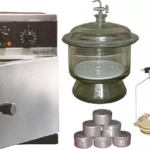Saturated surface dry (SSD) conditions refer to the state where the surface of the fine aggregate is neither saturated nor dry, but instead contains an optimal amount of moisture. It is a crucial state to achieve before measuring the specific gravity and absorption of the fine aggregate, as it ensures consistent and accurate results. This is important in Mix Design, in the Determination of Absorption, Specific Gravity, and other applications. This article outlines the procedure for attaining SSD conditions of fine aggregate.
Materials:
- Fine aggregate sample
- Tray
- Water
Procedure:
- Take a representative sample of the fine aggregate and determine its initial mass (M1).
- Submerge the fine aggregate in water and let it soak for a minimum of 15 hours, but not more than 19 hours.
- Remove the fine aggregate from the water and allow the excess water to drain for about 2 minutes.
- Place the fine aggregate on a flat, non-absorbent surface
- Using the cone and tamping rod, fill the cone and tamp 25 times. Clear the surroundings of the cone and gently remove the cone.
- Check the SSD condition as shown in the image below
- Repeat this procedure after reasonable periods until SSD condition is satisfied


- Sand 1 = Dry Condition
- Sand 2 = Wet Condition;
- Sand 3 = SSD Condition
Results:
The fine aggregate is now in a state of SSD, meaning that its surface is saturated but does not contain any excess moisture. This is the optimal state for measuring the specific gravity and absorption of the fine aggregate.
Conclusion:
Achieving SSD conditions is an important step in obtaining accurate and consistent results when measuring the properties of fine aggregate. Following this procedure will ensure that the fine aggregate is in the correct state for further testing.






